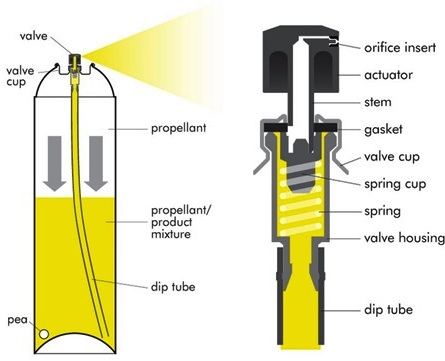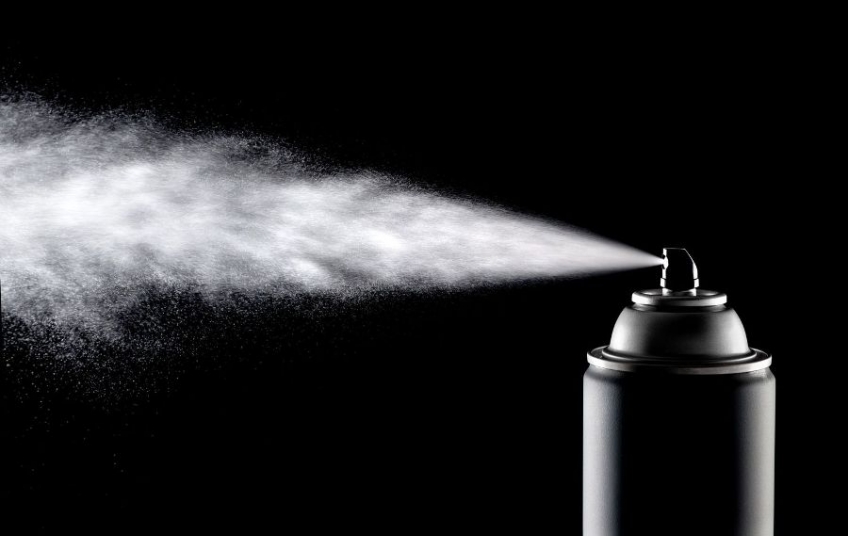Aerosols are suspended microscopic particles of liquids that vary in exerted distances from can containment. The particle sizes of aerosols also vary in size depending on the circumference of its outlet of departure in the nozzle which usually ranges from 10-4 to 10 micrometers. The particles of aerosols are reasonably visible ranging from a few meters to 200km. The most common forms of packaged aerosols are household cleaners, insect repellants, and medications such as nasal sprays and nebulizers. The typical canister for packaged aerosol commodities is manufactured from raw aluminum. The design concept of aerosol dispensers originated from Perpigna, a Frenchman, who envisioned inventing a siphon to dispense soda which contained mist valves as an experiment utilizing heavy steel and pressurized liquid. The modern, standard container was patented by Eric Rotheim, a chemical engineer, who developed the first multi-purpose aerosol can and valve system. As technology continues to advance with aerosol becoming more prevalent due to its variability in uses, concerns of sustainable practices have become one of the primary trepidations with manufacturers of aerosols and how they affect the ozone layer.
Aerosol spray containers offer a mass array of benefits to various industries due to its design adaptability. The most common uses are for industrial and medical purposes utilizing emissions from vapors and sprays for beneficial purposes. Design specifications are major facets of production within the realm of nozzle dispersion. These specialized designs determine the dispensed amount of product aerosol containers distribute and their drop size. The nozzle of the can is essentially the driving mechanical force of the aerosol container. Directly attached to the valve and its operable components when pressed, the nozzle dispenses microscopic particles of liquid into the air. Nozzle spray production has the ability to release a variety of spray pressures with unique dimensional properties. Air atomizing nozzles produce the smallest drop size due to its flat, cone-shaped nozzle formation and high pressure. Full cone nozzles produce the largest drop due to its low pressure and lower initial velocity. These droplets tend to travel further and affect a larger area of surface coverage. Examples of both are depicted in Figure 1. Specified operating conditions and purposes of production determine the appropriate nozzle type. An example of air atomizing nozzles are pressure washers and spray jets that apportion water at high speed with a significantly high-pressure impact. Household sprays are created using the full cone design with vertical nozzle. In the production process the cans are created using an injection molding actuator. In cases where the orientation of design is not particularly important are instances where products such as window cleaners or cosmetic sprays are dispensed through pumps. The size of the released particles from pumps vary, but the functionality of its swirl atomizer insert is relatively synonymous with those of gas-based aerosol cans and containers.

The properties of aerosol products vary by the propellant type and the amount of solution it comprises. In all instances, pressure is generated within a range of 0.7 to 9.8 “bars” at a standard temperature of 70F. Its flammable properties are among the hazardous content of the aerosol and its propellants. The dispersive content of propellant directly relates to molecular weight and pressure in a proportional matter. Propellants contain carbon dioxide that suspends petroleum distillates which then produces a relatively heavy spray. The more propellant substance added, the harsher the dispersion of spray is likely to be. It is recommended in practice to minimize the amount of propellant in order to have a mistier consistency. In the process of production vapor pressure, solubility, weathering, flammability, and nozzle specifications are primarily deliberated in the devising of aerosol. The propellants are categorized into three classes: soluble, compressed, and liquified gases. The most common organic compound of propellants is hydrocarbon which is obtained from natural sources under pressure.
The structure of aerosol containers solely depends on its purpose for use and cost/efficiency methodology implemented in the manufacturing process. Considering all aerosol containers function relatively the same, their structural composition also possesses similarities. Aerosol containers standard makeup consists of six major components: nozzle, stem, valve, propellant, dip tube, and product mixture. Each have intermediate components within their chief functionalities, but all contribute to the exertion of spray. The nozzle is the trigger point of operation for aerosol, but the mechanical instruments within the can itself switches the can on and off. The valve enables content of aerosol cans to be exerted through a pressurized system of inert gas. The liquified content of the can is considered the thermodynamic energy, and the mechanical energy is the propellant that lies at the top of the can.

- Nozzle – Varies in shape in size to accommodate the circumferential space area for intended use; possesses insert for spray dispersion
- Stem Gasket– Vertically attached to the nozzle; a small elastomer ring that is triggered once the nozzle is pressed. The stem presses the internal spring which opens the valve for product release
- Valve – Dispenses payload though dip tube and nozzle
- Propellant – Top layer of aerosol mixture that contains liquifies gas; usually serves as solvent, viscosity modifier, or refrigerant.
- Dip tube – The vertical stream feed that pulls content of can through all components of the can to release out of nozzle
- Product mixture – Main component of product
Aerosol cans work by pressing a nozzle that releases gasses into the atmosphere. Initial positioning for the cans is usually in the standard, “up” position. While the can is inoperative, the exit tube inside the can is closed as well. Valves within the aerosol container prevent the substances from escaping and is positioned tightly, restrained by a spring that when, pressed activates the rest of the mechanical components within the can (Woodford). Retractable valving is a relatively new form of packaging preservation that has been implemented to reduce waste of product and to preserve the content of what is contained in the welded bag attached to the canister and valving system. This relatively new method of technology is called Bag On Valving (BOV) and it optimizes sterility for products. As aerosols/sprays are dispensed, the content of the internal bag is squeezed by compressing nitrogen content. BOV has a continuous dispensing system that enables the product to be released continuously with no back contamination. The evacuation rate for BOV is 99.7%. The bag has multilayer films that provides an obstruction from contaminants. The process of filling consists of completely separating the propellants from the product which allows pure dispensing and filling of the actual product minus the additives. Pressurization from nitrogen surrounds the internal pouch that contains the product. When the nozzle (actuator) is activated, the nitrogen exerts pressure on the pouch which discharges the product. The “harmful” air is enclosed within the container and is not sprayed into ozone (Hinds).
Aerosol obtained its name from its gaseous nature when, in fact, the packaged liquids and gases are only clouds of proportioned liquids and gases. The contained mixture of liquid and gases are diverged under pressure and once dispensed, convert from its liquidous state to the vaporous gas. Earlier forms of aerosol contained a pressurized and liquidized gas that initially consisted of chlorofluorocarbons (CFC) which are now banned due to environmental detriment (Yumimoto). Aerosol constructs conservational concerns due to its gaseous and toxic content. According to the Environmental Protection Agency (EPA), household air fresheners are among the top contributors of the widespread expansion of air pollution. Although the fog contaminants that are usually considered the most hazardous to the environment are coal, petroleum, and biofuels, rarely are the effects of contained aerosols referred to when discussing concerns of potentially hazardous climate conditions (Kondratyev). The gases emitted from aerosols contribute to the Earth’s radiative energy imbalance. The ozone-exhausting compound, CFC, was the primary problem concerning the polluting of the ozone layer. Regulations implemented from the Clean Air Act restricted the use of harmful chemicals that manufactured aerosols previously gave off. Although household aerosols contribute less to the overall effect of global warming. To examine the role of pollutants that alter urban climate, there have been a derivation of a one-dimensional time-dependent model constructed that incorporates processes of heat transfer within the boundary layer of the ozone layer. The equation centers surface temperature (T0) from the continuity condition of net flux (Ackerman). The equation is set up as Rn+Hs+Hf=0 where Rn is the net radiative flux, Hs is the substrate heat flux, =1+B-1 where B is the Bowen ratio that represents flux measurements on energy balance, Hf is the sensible atmospheric heat flux. The assumption is that there is a direct linear decrease in heat flux that is consistent with aerosol affects and heat flux.
Sustainable practices are no longer considered a fad in the realm of manufacturing and product fabrication, especially when it comes to the production of aerosols. The goal of aerosol engineers and environmentalists is to opt out of traditional harmful chemical components replacing standard, detrimental hydrochlorides with air power. Companies such as Airopack founded by Quint Kelders, have been working to optimize the chemical composition to implement more sustainable practices. Noting the problem with using regular air while also acknowledging the fact that there are no current, preceding developments that integrate only full nitrogen and oxygen mixtures as a form of reference to brainstorm or further develop, Kelders worked to develop new technology that was simply unheard of in terms of pure product consumption. Taking in to consideration that only 40% of packaged aerosol containers possess only the product itself in the absence of propellants, this causes a stir in company transparency in the eye of the consumer. Airopack is working to revolutionize ways to diminish the use of propellants and to find ways to package only the product dispensed by air content. Published sustainability reports from Airopack exhibit their ability to package air-propelled dispensers with 100% product content while also being transparent with consumers. Their costs of production and manufacturing only costs a third of what would traditionally be accounted for in in aerosol production with the propeller factor out of the picture (EuropeanCEO).
With the aid of environmental policies and new technologies that moderate costs of aerosol production, the industry for aerosol has become more efficient and sustainably-savvy over the past five years. Ridding of environmental contaminants, being mindful of excessive usage of aerosols, and the proper disposal of containers are ways to improve atmospheric, ozone conditions and to restore a safer, cleaner planet once and for all.
References
Ackerman, Thomas P. “A Model of the Effect of Aerosols on Urban Climates with Particular Applications to the Los Angeles Basin.” Department of Atmospheric Science, University of Wisconsin.
EuropeanCEO. “Why Air-Powered Aerosols Are The Future Of Sustainable Packaging.” 2018.
Hinds, William C. “Aerosol Technology: Properties, Behavior, and Measurement of Airborne Particles.”
Kondratyev, Kirill Ya. Ivlev, Les S. Krapivin, Vladimir F. “Atmospheric Aerosol Properties: Formation, Processes and Impacts”.
Yumimoto, K., and T. Takemura (2011), Direct radiative effect of aerosols estimated using ensemble‐based data assimilation in a global aerosol climate model, Geophys. Res. Lett., 38, L21802, doi: 10.1029/2011GL049258.
Woodford, Chris. “Aerosol Cans”. Explain That Stuff. June 2014.
Figures
Figure 1:
Guideline for Spray Nozzle Selection. (Photograph). 2016. https://www.spray.com/pdf/dust_control_nozzle_selection.pdf
Figure 2:
“Propellant.” (Photograph). http://filmi-onlain.info/jpgppng-propellant.shtml


































